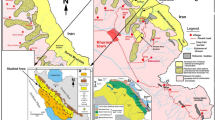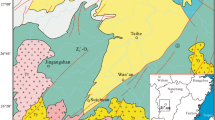Abstract
This study evaluated the Cretaceous (Campanian–Maastrichtian) kaolinitic sediments of the Ajali/Mamu and Enugu/Nkporo Formations from the Lower Benue Trough of Nigeria. A combined method of inductively coupled plasma–mass spectrometry and isotope ratio mass spectrometry was used to investigate trace and rare-earth element geochemistry and hydrogen and oxygen isotopic compositions. These data were then used to infer the sediments’ provenance and paleoclimatic conditions during their deposition. The sediments contained low concentrations of most trace elements, with the exceptions of Zr (651–1352 ppm), Ba (56–157 ppm), V (38–90 ppm), and Sr (15.1–59.6 ppm). Average values of Co and Ni were 1.5 and 0.7 ppm, respectively. Trace and rare earth element values were lower than corresponding values for upper continental crust and Post-Archean Australian Shale, with the exception of Zr. The samples showed only slight light rare-earth enrichment and nearly flat heavy rare-earth depletion patterns, with negative Eu and Tm anomalies, typical of felsic sources. Geochemical parameters such as La/Sc, Th/Sc, and Th/Co ratios support that the kaolinitic sediments were derived from a felsic rock source, likely deposited in an oxic environment. 18O values ranged from + 15.4 to + 21.2‰ for the investigated samples, consistent with a residual material derived from chemical weathering of felsic rock and redeposited in a sedimentary basin (typical values of + 19 to + 21.2‰). While in the basin, the sediments experienced extended interactions with meteoric water enriched in δD and δ16O. However, the variation in δD and δ16O values for the investigated samples is attributed to the high temperature of formation (54–91 °C). The δD and δ18O values suggest that the sediments, although obtained from different localities within the Lower Benue Trough, formed under similar hot, tropical climatic conditions.







Similar content being viewed by others
References
Akande SO, Hoffknecht A, Erdtmann BD (1992) Environment of ore formation and anchizonal metamorphism in Pb-Zn-Ba-F deposits of the Benue Trough, Nigeria. Geolgie en Miijnbouw 71:131–144
Armstrong-Altrin JS, Lee YI, Verma SP, Ramasamy S (2004) Geochemistry of sandstones from the Upper Miocene Kudankulam Formation, southern India: implications for provenance, weathering, and tectonic setting. J Sediment Res 74:285–297
Baioumy H (2013) Hydrogen and oxygen isotopic compositions of sedimentary kaolin deposits, Egypt: Paleoclimatic implications. Applied Geochemistry, pp 182–188
Bigeleisen J, Perlman ML, Prosser HC (1952) Conversion of hydrogenic materials to hydrogen for isotopic analysis. Anal Chem 24:1356–1357
Bird MI, Chivas AR (1988) Stable-isotope evidence for low-temperature kaolinitic weathering and post-formational hydrogen-isotope exchange in Permian kaolinites. Chem Geol Isot Geosci Sect 72:249–265
Boynton WV (1984) Geochemistry of the rare earth elements: meteorite studies. In: Henderson P (ed) Rare earth element geochemistry. Elsevier, pp. 63–114
Clayton RN, Mayeda TK (1963) The use of bromine pentafluoride in the extraction of oxygen from oxides and silicates for isotopic analysis. Geochim Cosmochim Acta 27:43–52
Cox R, Lowe DR, Cullers RL (1995) The influence of sediment recycling and basement composition on evolution of mudrock chemistry in the south-western United States. Geochim Cosmochim Acta 59:2919–2940
Craig H (1961) Standard for reporting concentrations of deuterium and oxygen-18 in natural waters. Science 133:1833–1834
Cullers RL (1995) The controls on the major and trace element evolution of shales, siltstones and sandstones of Ordovician to Tertiary age in the Wet Mountain region, Colorado, USA. Chem Geol 123:107–131
Cullers RL, Barrett T, Carlson R, Robinson B (1987) Rare mineralogic changes in Holocene soil and stream sediment: a case study in the wet mountains region, Colorado, USA. Chem Geol 63:275–297
Cullers RL, Basu A, Suttner L (1988) Geochemical signature of provenance in sand-size material in soils and stream sediments near the Tobacco Root batholith, Montana, USA. Chem Geol 70:335–348
Dansgaard W (1964) Stable isotopes in precipitation. Tellus 16:436–468
Friedman I (1964) The variation of the deuterium content of natural waters in the hydrological cycle. Rev Geophys 2:177–224
Gazis C, Taylor HP Jr, Hon K, Tsvetkov A (1987) Late Cretaceous lateritic-derived sedimentary deposits (oolitic ironstone, kaolin deposits, bauxite) in Upper Egypt. Berl Geowiss Abh 75:727–758
Gilg HA (2000) D/H evidence for the timing of kaolinization in Northeast Bavaria, Germany. Chem Geol 170:5–18
Gofiantini R (1984) Report on the advisory group meeting on stable isotope reference samples for geochemical and hydrological investigations. Rep. Dir. Gen. IAEA, Vienna, 77
Gromet LP, Dymek RF, Haskin LA, Korotev RL (1984) The ‘North American Shale Composite’: its compilation, major and trace element characteristics. Geochim et Cosmochim Acta 48:2469–2482
Hallberg RO (1976) A geochemical method for investigation of palaeo redox conditions in sediments. Ambio Special Rep 4:139–147
Hassanipak AA, Eslinger EV (1985) Mineralogy, crystallinity, 180/160 and D/H of Georgia kaolins. Clays Clay Miner 33:99–106
Idakwo SO, Barnabas GY, Alege ST, Alege KE (2013) Paleoclimate reconstruction during Mamu Formations (Cretaceous) based on clay mineral distribution in Northern Anambra Basin, Nigeria. Int J Sci Tech 2:879–885
Jones B, Manning DC (1994) Comparison of geochemical indices used for the interpretation of paleo-redox conditions in ancient mudstones. Chem Geol 111:111–129
Lawrence JR, Taylor HP Jr (1971) Deuterium and oxygen-18 correlation. Claystone Geochim Cosmochim Acta 36:1377–1393
Lawrence JR, Taylor HP Jr (1972) Hydrogen and oxygen isotope systematics in weathering profiles. Geochim Cosmochim Acta 36:1371–1393
Levinson AA (1974) Introduction to exploration geochemistry. Applied Publishing, Illinos, p 612
Liu B, Wang Y, Su X, Zheng H (2013) Elemental geochemistry of northern slope sediments from the South China Sea: implications for provenance and source area weathering since Early Miocene. Chem Erde 73:61–74
Longstaffe FJ, Ayalon A (1990) Hydrogen-isotope geochemistry of diagenetic clay minerals from Cretaceous sandstones, Alberta, Canada: evidence for exchange. Appl Geochem 5:657–668
McLennan SM (1989) Rare earth elements in sedimentary rocks: influence of provenance and sedimentary processes. Geochem Mineral Rare-Earth Elem Rev Mineral 21:169–200
McLennan SM, Taylor SR (1991) Sedimentary rocks and crustal evolution: tectonic setting and secular trends. J Geol 99:1–21
McLennan SM, Nance WB, Taylor SR (1980) Rare earth element-thorium correlations in sedimentary rocks, and the composition of the continental crust. Geochim Cosmochim Acta 44:1833–1839
McLennan SM, Hemming S, McDaniel DK, Hanson GN (1993) Geochemical approaches to sedimentation, provenance, and tectonics. In: Johnson MJ, Basu A (eds) Processes controlling the composition of clastic sediments, Special paper, Geological Society of America, vol 284, 21–40
Mizota C, Longstaffe FJ (1996) Origin of Cretaceous and Oligocene kaolinites from the Iwaizumi Clay deposit, Iwate, Northeastern Japan. Clay Clays Miner 44:408–416
Murray HH, Janssen J (1984) Oxygen isotopes-indicators of kaolinite genesis. In: Proceedings of 27th international geological congress, non metallic ores, vol 15, pp 287–303
Nath BN, Bau M, Ramalingeswara Rao B, Rao CM (1997) Trace and rare earth elemental variation in Arabian Sea sediments through a transect across the oxygen minimum zone. Geochim Cosmochim Acta 61:2375–2388
Obaje NG (2009) Geology and mineral resources of Nigeria. Springer, Berlin
Odoma AN, Obaje NG, Omada JI, Idakwo SO, Erbacher J (2015) Mineralogical, chemical composition and distribution of rare earth elements in clay-rich sediments from southeastern Nigeria. J Afr Earth Sci 102:50–60
Okunlola OA, Idowu O (2012) The geochemistry of claystone-shale deposits from the Maastritchian Patti formation, Southern Bida basin, Nigeria. Earth Sci Res J 16:57–67
O’Neil JR, Kharaka YK (1976) Hydrogen and oxygen isotope exchange reactions between clay minerals and water. Geochim Cosmochim Acta 40:241–246
Petters SW (1982) Central West African Cretaceous-Tertiary benthic foraminifera and stratigraphy. Palaeontographical Sonder – Abduck aus Palaeontographica, vol 179, pp 1–104
Puchelt H (1972) Barium. Handbook of geochemistry (Wedepohl KH et al, eds), B1 56O2, Springer, Berlin
Reyment RA (1965) Aspect of the geology of Nigeria. University Ibadan Press, Nigeria
Savin SM, Epstein S (1970) The oxygen and hydrogen isotope geochemistry of claystone minerals. Geochim Cosmochim Acta 34:25–42
Savin SM, Hsieh JCC (1998) The hydrogen and oxygen isotope geochemistry of pedogenic clay minerals: principles and theoretical background. Geoderma 82:227–253
Savin SM, Lee M (1988) Isotopic studies of phyllosilicates. In: Bailey SW (ed) Hydrous phyllosilicates (exclusive of Micas), Reviews in Mineralogy Paper 19, pp 189–223
Sheppard SMF, Gilg HA (1996) Stable isotope geochemistry of clay minerals. Clay Miner 31:1–21
Sheppard SMF, Neilsen RL, Taylor HP Jr (1969) Oxygen and hydrogen isotope ratios of clay minerals from porphyry copper deposits. Econ Geol 64:755–777
Singh M, Sharma M, Tobschall HL (2005) Weathering of the Ganga alluvial plain, northern India: implications from fluvial geochemistry of the Gomati River. Appl Geochem 20:1–21
Stow DAV, Atkin BP (1987) Sediment facies and geochemistry of Upper Jurassic mudrocks in the central North Sea area. In: Brooks J, Glennie K (eds) Petroleum geology of North West Europe, Graham and Trotman, London, 797–808
Taylor SR, McLennan SM (1985) The continental crust: its composition and evolution. Blackwell, Oxford, p 312
Wronkiewicz DJ, Condie KC (1990) Geochemistry and mineralogy of sediments from the Ventersdorp and Transvaal Supergroups, South Africa: cratonic evolution during the Early Proterozoic. Geochim Cosmochim Acta 54:343–354
Yurtsever Y, Gat JR (1981) Atmospheric waters. In: Gat JR, Gonfiantini R (eds) Stable isotope hydrology: Deuterium and oxygen-18 in the water cycle. International Atomic Energy Agency, Vienna, pp 103–142
Zaborski PM (1998) A review of the cretaceous system in Nigeria. Afr Geosci Rev 5:385–483
Zhou T, Dobos SK (1994) Stable isotope geochemistry of kaolinite from the white section, Black Ridge, Clermont, Central Queensland: implications for the age and origin of the white section. Clays Clay Miner 42:269–275
Acknowledgements
The authors appreciate the assistance of Matthew Lilley, Benjamin Underwood, and Peter Sauer of the Department of Geological Sciences, Indiana University, Bloomington, Indiana, USA for their assistance with the oxygen extraction and with oxygen and hydrogen isotope analyses.
Author information
Authors and Affiliations
Corresponding author
Rights and permissions
About this article
Cite this article
Bolarinwa, A.T., Idakwo, S.O. & Bish, D.L. Rare-earth and trace elements and hydrogen and oxygen isotopic compositions of Cretaceous kaolinitic sediments from the Lower Benue Trough, Nigeria: provenance and paleoclimatic significance. Acta Geochim 38, 350–363 (2019). https://doi.org/10.1007/s11631-019-00328-y
Received:
Revised:
Accepted:
Published:
Issue Date:
DOI: https://doi.org/10.1007/s11631-019-00328-y




